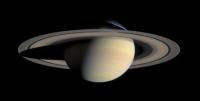Saturn accused of 'murder' and other violent acts
 Hundreds of thousands of news sites carried this image with the caption: "Saturn’s rings: Leftovers from a cosmic murder?" NASA image.
Hundreds of thousands of news sites carried this image with the caption: "Saturn’s rings: Leftovers from a cosmic murder?" NASA image.
Do some writers go over the top anthropomorphizing inanimate objects to get readers? Do most news outlets take the bait?
Ya gotta love press release writers, especially those of the astronomical science persuasion. I’d say they are frustrated fiction novelists, but I think their real goal is to get people interested in things astronomical and the mysteries of the universe.
Case in point: Two versions of the same story I ran across on aol.com (the long in-depth version) and the Los Angeles Daily News (the simplified, shorter version), both of which were taken from a new theory by Robin Canup, an astronomer at the Southwest Research Institute in Boulder, Colorado, which was published online Sunday, Dec. 12, in the journal Nature.
From both stories, (and about 400,000 others): “…those spectacular and colorful rings are the only evidence left. As the doomed moon made its death spiral, Saturn robbed its outer layer of ice, which then formed rings.” And, “One of the leading theories has been that either some of Saturn's many moons crashed into each other, or an asteroid crashed into some of them -- leaving debris that formed the rings. The trouble is Saturn's moons are half ice and half rock and the planet's seven rings are now as much as 95 percent ice and probably used to be all ice. If the rings were formed by a moon-on-moon crash or an asteroid-on-moon, there would be more rocks in the rings.”
Since their discovery, Earthlings interested in our solar neighbors have been trying to figure out how Saturn’s spectacular rings came into being, a mystery that may never be solved. But to make an actual murder mystery out of it?
The accusation that one of Saturn’s many moons deliberately and with malice of forethought crashed into another, therefore causing it to plummet to the planet’s surface leaving behind icy debris, is just going a bit too far to get us to read the story. It’s a fanciful description, but anthropomorphizing inanimate outer space objects just as they do meteorological storms to get the readers attention is really comedy of the absurd.
To describe comets as “killers” or storm as “vicious” implies that they have brains and human intent on doing destruction when they are doing no more than carrying out a natural confluence of events.
The science channels are just as bad. Ratings driven, they have to exaggerate everything: The sun is going to burn itself out in a massive explosion killing off Earth and all of its inhabitants! If you’re a newbie to the study of astronomy you may want to run for hills or start digging a backyard bunker, because it takes a while for the producers and writers of these shows to get around to the fact that our sun won’t go nova for another 4.5 billion years. Who cares? This is one case where we can all be Scarlet O’Hara and worry about it tomorrow…or the day…or next year…or the next hundred, million, billion millennia.
Not only that, but two billion years before that, our nearest neighbor, the Andromeda galaxy, is scheduled to come crashing into our Milky Way. Now there’s something to worry about! After all, that’s only two-and-a-half billions years down the road.



 del.icio.us
del.icio.us Digg
Digg












Post your comment